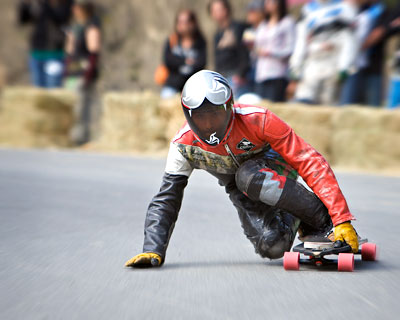 Regardless of their experience level, skateboarders, longboarders, and cyclists inevitably fall. If they are prepared for a fall with all the right protective gear, and fall in the way they expect, then they'll probably bounce right up again and keep going without a second thought. But some falls result in direct skin to pavement contact (road rash).
Regardless of their experience level, skateboarders, longboarders, and cyclists inevitably fall. If they are prepared for a fall with all the right protective gear, and fall in the way they expect, then they'll probably bounce right up again and keep going without a second thought. But some falls result in direct skin to pavement contact (road rash).
If you are parent of a skater or rider and haven't had to clean a nasty spill, plucked pebbles from raw shredded skin, trust me: you will. Falls are going to happen. Even padded and helmeted skateboarders tumble and wind up with scrapes on shoulder blades, hip bones and other areas that typically aren't protected. Most cases of road rash aren't sufficient to warrant a trip to the hospital, so, as resident medic, you ought to know some of the latest recommendations for treating road rash that encourages fast healing.
First aid supplies
You should have the following supplies on hand to treat road rash:
- Saline solution of 0.9 % sodium chloride
- Non-stick gauze pads of varying sizes
- Paper skin tape
- Bioclusive dressing, 3M Tegaderm , 2nd Skin or other similar dressing
- A new spray bottle, or syringes (for washing grit from wound)
- Cleansing pads
The conventional treatment of road rash, which I have personally endured, used to include scrubbing of the wound, cleansing with rubbing alcohol and treating with an antibiotic ointment and a dry dressing. For more on the issues of skin abrasion, road rash and turf burn from a 2001 issue of the journal The Physician and Sportsmedicine, click here.
Quick action important
When an injury involves dirt and rocks, quick treatment is important to reduce the risk of infection. Don't scrub the wound as this will traumatize the tissue further. Instead, shower off and spray the wounded area thoroughly. If after showering there are still imbedded particles, then use a spray bottle or syringe of saline solution to continue to clean the wound until it is perfectly clean.
Clean thoroughly
It is critical to clean the fresh wound as if it begins to heal with foreign matter still in it, it will most likely become infected. Even then, it will still need to be cleaned; but it will be much more painful.
Keep moist and covered
This may involve changing dressings daily or more frequently, depending on the severity of the scrape. The bioclusive type dressings keep the wound moist and protected from contamination at the same time as allowing evaporation of the exudates )the ooze from the sore). This process allows the healing from the bottom of the scrape as well as from the sides. Because the wound stays moist, the scab does not form a hard crust, which on knees and other bendy body part has a tendency to crack open upon movement.
Spot infections
If the pain worsens, or if the surrounding tissue becomes red or angry looking, you should go to see a doctor. Bacterial infections can become serious if not treated promptly. Infections near joints can be particularly bad; do not hesitate to seek professional medical attention if you suspect an infection. It is really much better to be safe than sorry.
Lorrie Miller is a mother, teacher and writer in Vancouver, BC, Canada. Her son, Wolfgang (that's him in the photo during a race), competes in downhill longboarding.








